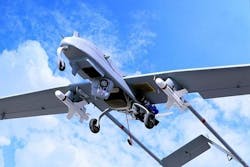Are future revolutionary weapons like tiny armed UAVs inevitable?
Still, due to their sheer utility and relatively low costs, there are some things that the military inevitably will be dragged into, kicking and screaming, whether the current generation of Pentagon leaders like them or not.
One case in point is the proliferation of armed unmanned aerial vehicles (UAVs). Sure, we have armed UAVs today like the General Atomics Predator and Reaper UAVs. I don't think it will be much longer, however, before we see armed UAVs of ever-smaller types.
Large numbers of armed UAVs flying inside and outside of combat zones would have enough obvious risks to make members of the U.S. Joint Chiefs of Staff wake up at night in cold sweats. How could military authorities assert reliable positive control over so many armed drones? What about the potential for collateral damage from a small UAV attack? How could we prevent that, and who would be responsible if things were to go horribly wrong?
Related: Air Force orders eight MQ-9 Block 5 Reaper attack drones from manufacturer General Atomics
Valid concerns, all. Still, fleets of small armed UAVs represent such a compelling idea on so many levels that political, military, and technology concerns will have a difficult time holding back the tide. More to the point: if we don't do it, somebody else will.
Perhaps the biggest concern about the proliferation of armed UAVs involves the notion of "man in the loop." That means a human at some stage in the chain of command has to give the order to shoot. Without a human in the loop -- in theory, at least -- the missiles stay on the rails, even in case of the juiciest opportunities to wreak havoc on the enemy.
Growing numbers of armed UAVs in the air, however, puts big pressure on the notion of man in the loop. Things can happen on the battlefield too quickly for senior leaders to respond to efficiently. Increasing levels of machine automation, moreover, will make future generations of small armed UAVs perfectly capable of detecting, pinpointing, characterizing, and shooting at enemy targets -- all on their own.
Put all that together and you've got a lot of armed UAVs aloft with itchy trigger fingers and a limited ability of the top echelons of command to control them. It's not a pretty sight, but I wonder, honestly, if modern militaries in the U.S. and elsewhere will be able to resist the trend.
Related: Raytheon wins job to build lightweight missiles for attack UAVs and special-ops aircraft
Armed UAVs represent a new generation of sophisticated, inexpensive, and lethal firepower. Military budgets are tight, which makes relatively inexpensive weapon systems an overwhelming temptation. Do we want to buy 100 F-35 manned fighters, or 5,000 armed UAVs that warfighters on the ground or human pilots nearby could fly? That wouldn't be such a hard of a choice if we faced some dire threats to national security.
Perhaps we could head-off this trend, and then again, perhaps not. The genie, in fact, may already out of the bottle.
U.S. military forces just recently began air attacks on ISIS forces in Syria. Among those forces are U.S. AH-64 Apache attack helicopters with the ability to control relatively small Textron Shadow catapult-launched UAVs.
Related: AeroVironment to supply Blackwing mini UAVs for Navy attack, guided missile submarines
These Shadow unmanned aircraft don't need runways to operate; they just need towed catapults and arresting wires to take off and land from unimproved battlefield sites or even from surface ships. Right now they're being used for surveillance, but what might the future bring?
Textron reportedly has demonstrated the Shadow armed with the small Fury laser-guided missile from Thales UK. For now U.S. military leaders haven't shown interest in an Armed Shadow, but when might such a thing become overwhelmingly attractive? It's small, supportable, and priced right for an overburdened military under serious budget pressures.
So here we find ourselves. Are future swarms of armed UAVs inevitable? I think so. Now the real question becomes what kinds of enabling technologies and military doctrines do we need to make such a future safe and manageable?

